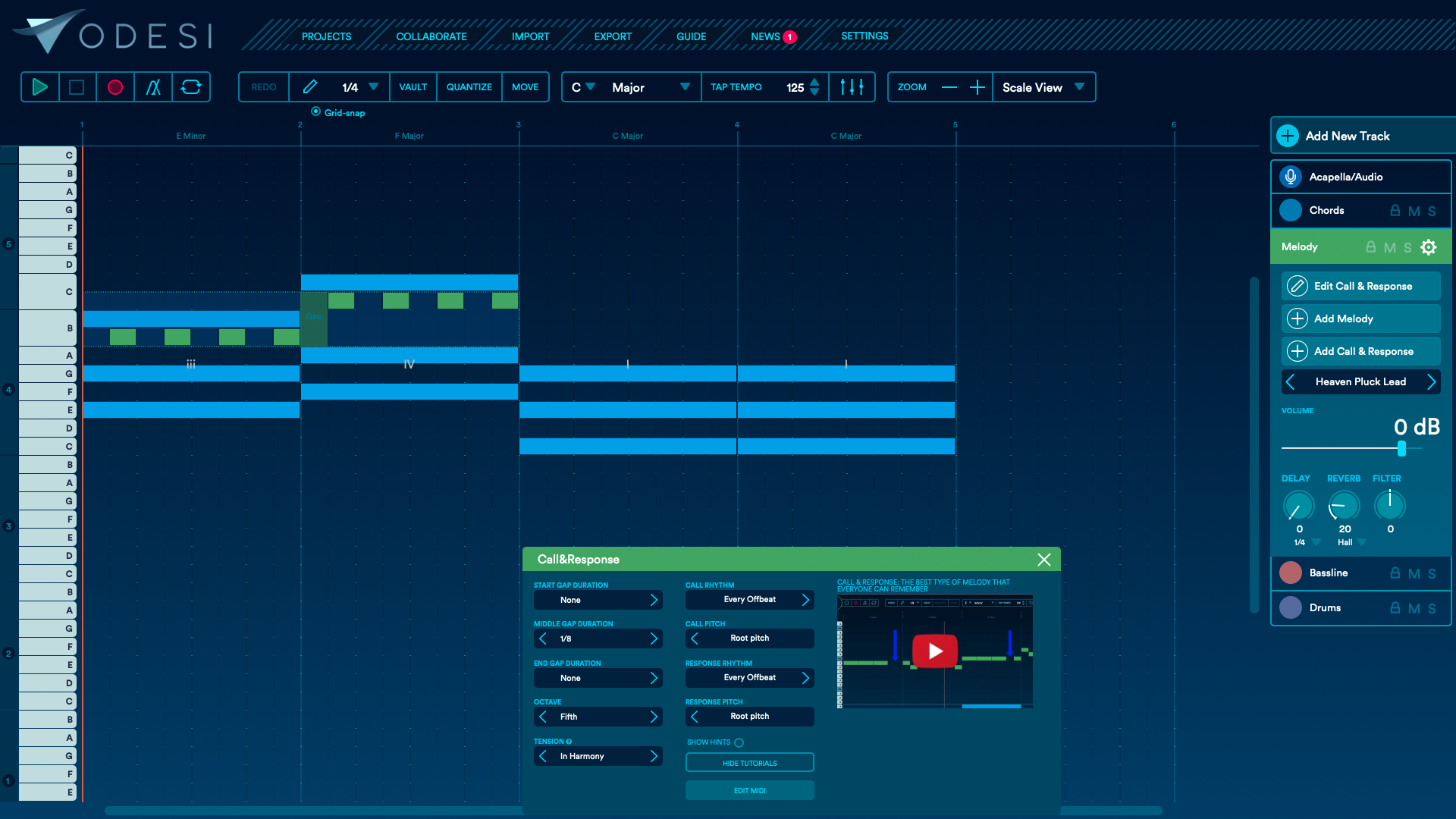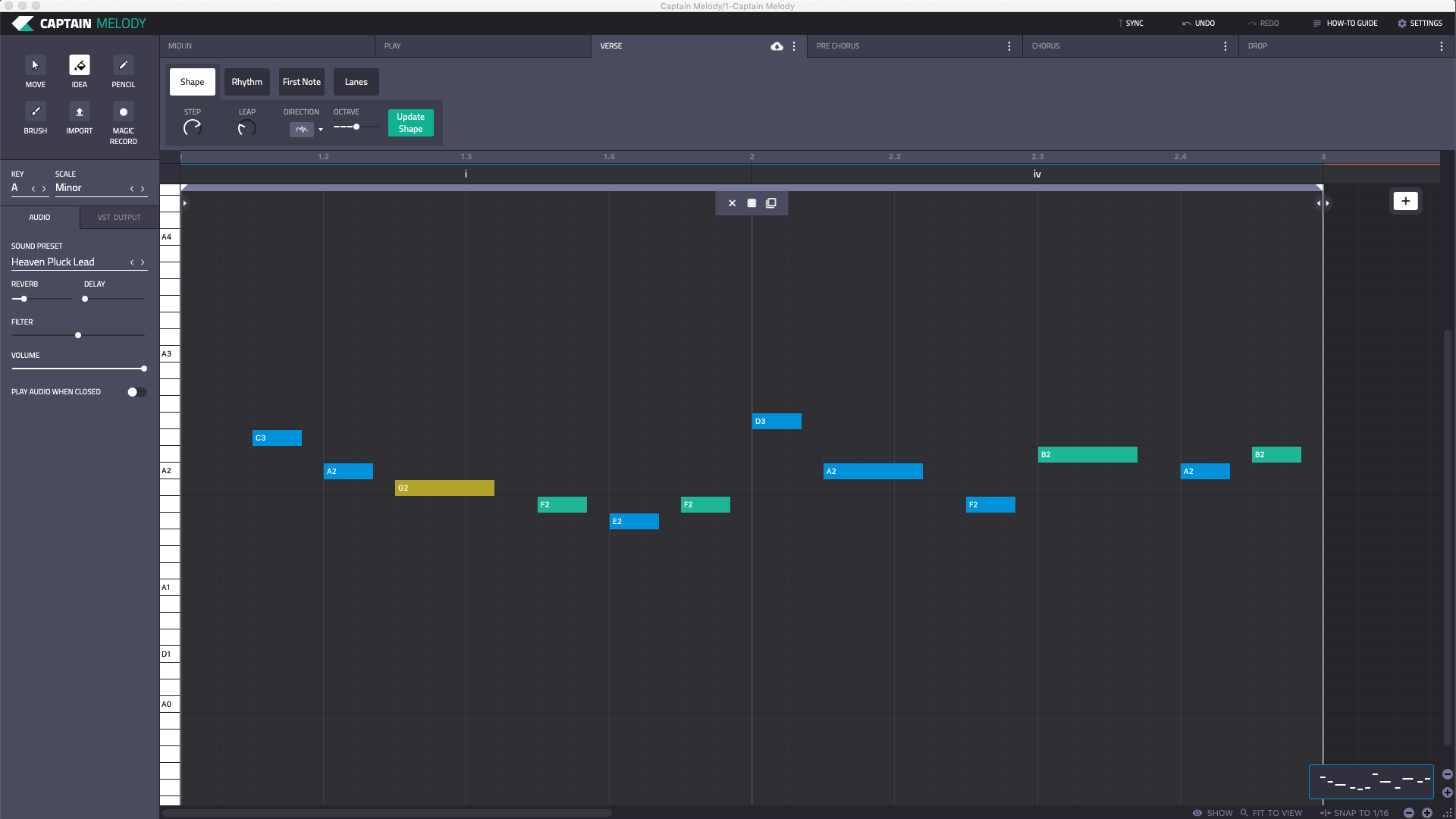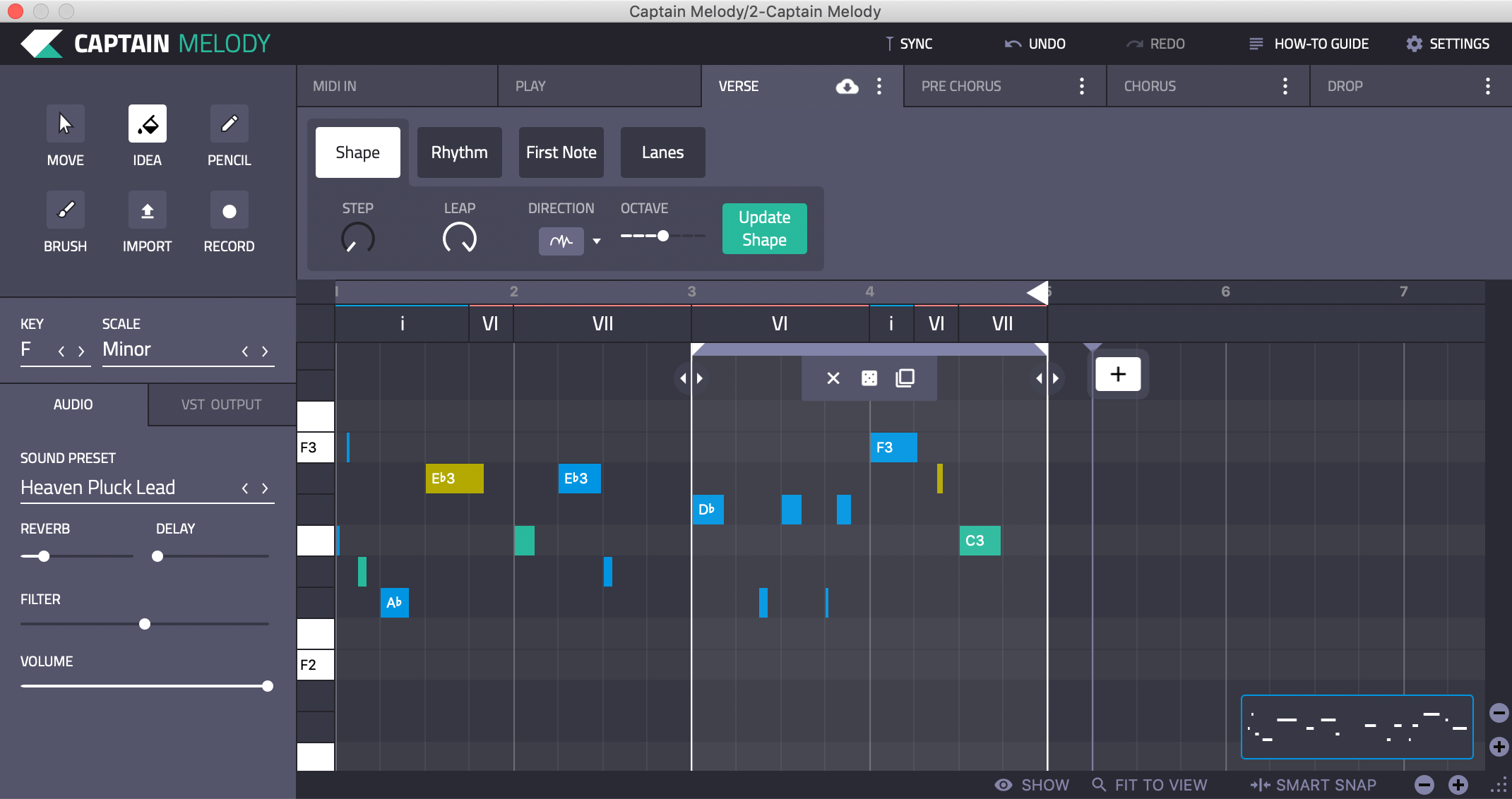Melody Writing.
Melody is usually the most memorable part of a song, so you want to make sure yours are bossing it. Learn how to write better melodies with Captain Plugins & Odesi.

Captain Melody 5.0
- Write melodies that suit your chord progression
- Connect the Melody plugin with Chords plugin
- Apply different rhythms
- Apply arpeggiators that move your MIDI notes
- Adjust the tension between the Chords and Melody
- Hear the melody played with 100+ different sounds
Different types of melody.
Melody writing can take many forms. Some melodies use a call and response method, others use arpeggios, some use counter-melodies, while some have minimal variation, even employing just one or two notes.
Here are some examples of each type of melody:
- Call and Response: The first part, or call, sets up the second. The ‘call’ and ‘response’ are usually simple, but noticeably different to each other and seperated by a gap.
- Monophonic/Duophonic melody: In Dr Dre Ft Snoop Dogg – Still D.R.E the vocal melody consists of just two
notes. The rhythm becomes super important, as a result.
- Counter-melody: Ed Sheeran & Khalid – Beautiful People use counter-melody to great effect. The lead
vocal sings the most promnent melody, while the counter-melody adds depth, and is sung by a chorus of new
voices. It’s explained in detail here:
- Mix n’ match: Katy Perry – Bon Appetit uses a mixture of techniques. It starts with a Call, which is the
repeated, and moves onto the response, in which faster rhythm and repetition are used to increase drama.
Odesi has a dedicated Call & Response function, which allows you to tailor each aspect of the melody. Find out more here: Call & Response in Odesi
Call & Response in Odesi.
Odesi has an awesome feature for designing great melodies. Simply click ‘Call & Response’ in the Melody section and you’ll open up a world of harmonic possibilities!

You can adjust every parameter of your call and response melody until it sounds perfect. From increasing or decreasing the middle gap to switching up the root note or rhythm of the call and/or the response, Odesi lets you find your perfect melody. And it’s always in key and scale with your chords.
Visit the official Odesi homepage and find out how it can help you write amazing, original music.
Top-line Techniques.
The Pegasus method.
Captain Plugins also has some incredible tools for creating melodies. You can use Captain Melody in many different ways to craft amazing top-lines. Try using the Pegasus method and see if it helps your composition. It’s a method of compartmentalising the writing process into two distinct aspects; rhythm, and tune. Firstly, you tap out your desired rhythm, using only one note. This is great because it lets you feel the track without getting distracted by melodic construction. Once your rhythm is down, you can then start generating the melody using Captain Melody’s deep composition tools. Check out our tutorial on the Pegasus method right here:
Create arpeggios with rhythm presets.
Captain Melody comes with some awesome preset rhythms, which you can then easily turn into arpeggios. It’s similar to the Pegasus workflow, but uses our incredibly popular hit rhythms. Check out our tutorial on this method right here:
Create arpeggios with rhythm presets.
If you’re adept with a MIDI keyboard, you can use Captain Melody as a MIDI canvas, and then develop your ideas further using the plugin’s composition features. Check out Mau Montekio’s awesome tutorial on this method right here:
Heavenly melodies
Regardless of your level of music theory, you know when a melody is good, because it sounds like it belongs in the song, and you find yourself humming it long after you stop writing. If you’re not, chances are it’s a forgettable melody.
Writing great melodies is a lot about feeling – a good songwriter is skilled at funnelling their feelings into music. However, there is also a large element of skill and theory involved, too. Does the melody suit the rest of the song? Does it convey the right kind of emotion? Is it catchy? Too complex? Maybe it’s too simple? Does the rhythm jar with the drum beat or sound like it fits?
These are all conundrums that a song-writer has to consider, and they can all be resolved using music theory.

Idea shower.
These conundrums can make or break a melody. And with Captain Melody, you have the power to answer these complex theoretical questions in an intuitive, easy-to-use plugin.
In particular, Captain Melody’s Idea tool is a supremely capable tool for writing melodies with total control of the sound. Each aspect of melody writing can be tweaked and controlled to generate original, unique melodies.
This is achieved by using ‘Idea boxes’.
Inside each Idea box, notes are auto-generated. These notes will be in your chosen scale and key, and – if you have connected Captain Melody to Captain Chords – will also be in tune with your chord progression. Then, with the notes on the canvas, you can use the Idea tools to edit, adjust and rework the melody until it’s just right. This tool is fascinating because it manages to give you complete creative control, and yet is likely to surprise and inspire you as you combine parameters. And, if you need to make minor adjustments, you can still edit the MIDI notes in the traditional way.

Think inside the box.
The controls in Captain Melody’s Idea boxes allow you to write melodies which are rooted in deep music theory, regardless of your personal experience.
More, even, than simply a tool which gives you mastery of music theory, it is a tool that generates happy accidents… just like having a jam on a real keyboard might. It’s a ground-breaking and inspiring tool for writing melodies that will leave you inspired and amazed.
Write better melodies with Captain Plugins
It’s super easy to create your own ideas from scratch. Visit the official Captain Plugins homepage and see how it will help you explore music and write your own original productions.
